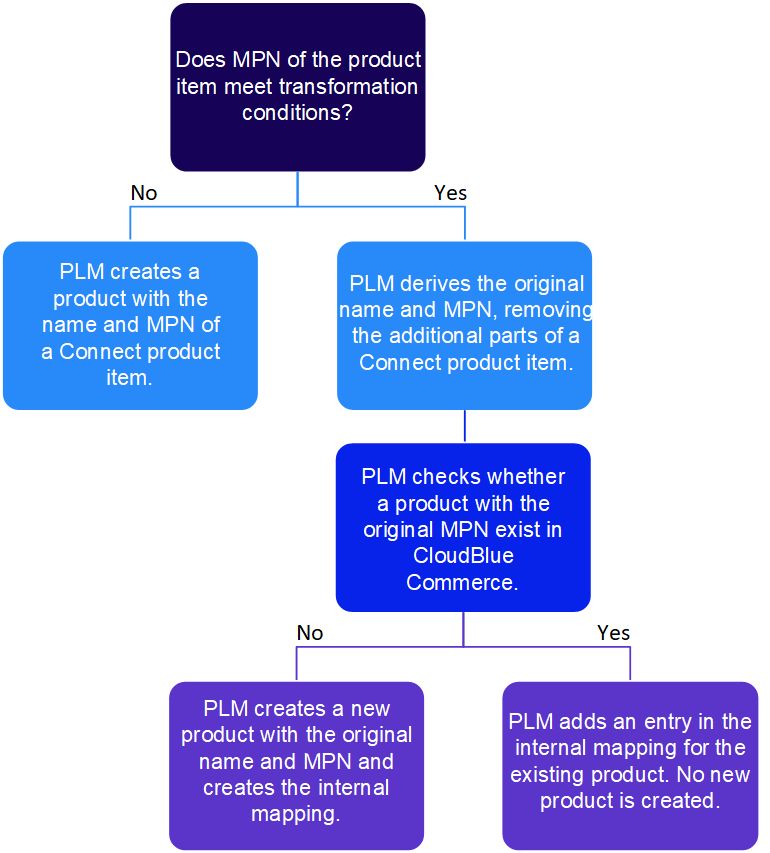Note: To get familiar with PLM terminology, refer to the Glossary.
PLM supports integration with external fulfillment systems that act as a source of product information for initial portfolio configuration and further updates. CloudBlue Connect is supported out of the box.

Vendors use the CloudBlue Connect functionality to configure their portfolio. The vendor's product information is transformed from CloudBlue Connect to CloudBlue Commerce as follows:

Note: If Administrative Hold is set to Off in a CloudBlue Connect product, PLM will send cancellation requests to CloudBlue Connect only when a subscription is destroyed. A subscription cancellation operation, which does not destroy the subscription, will not initiate a request in CloudBlue Connect. To cancel and destroy simultaneously, the Destroy on Cancel parameter of a service template must be switched on.
Flat and Hierarchical product catalogs
CloudBlue Connect and CloudBlue Commerce use different types of product catalogs: flat and hierarchical.
-
In a flat catalog, a unique identifier is set for a combination of a product item with a billing and commitment period. CloudBlue Connect operates only with the flat catalog.
-
In a hierarchical catalog, a product with its unique identifier can be distributed with any billing or subscription period. It does not require a unique identifier for every combination of these periods. CloudBlue Commerce is designed to operate with the hierarchical catalog; however, it can also work with the flat one. Different vendors may use different catalog types to meet their requirements.
In theory, in order to satisfy the CloudBlue Connect product definition, vendors who use a hierarchical catalog in CloudBlue Commerce must transfer it to a flat one. Such an operation involves increasing the number of catalog items and setting artificial identifiers for these items, which are absent in the original vendor catalog.
PLM offers the solution that allows a vendor to use a hierarchical catalog in CloudBlue Commerce based on the CloudBlue Connect product definition and make use of its advantages, such as:
-
Keeping original product identifiers (MPN) in a catalog,
-
A brief and intuitive showcase in the Marketplace,
-
A shorter catalog, which is simpler to keep up to date.
To be able to transform the information from an external catalog, the MPN and product item name in CloudBlue Connect must meet transformation conditions.
Transformation conditions
This table outlines the conditions for transformation of product information from CloudBlue Connect when creating products automatically by importing information from CloudBlue Connect.
| CloudBlue Connect | CloudBlue Commerce | Comments |
|---|---|---|
| MPN | ||
| <Vendor_Product_ID>_<Commitment_term>:<Billing_frequency> |
|
An example of a CloudBlue Connect MPN is CFQ7TTC0HDK0:0001_P1M:Monthly, where:
In this example, the CloudBlue Connect MPN value will be transferred to CloudBlue Commerce as:
Note: MPNs for qualified Microsoft products, that is, those include the suffixes EDU, NPF, and GCC in the MPNs of CloudBlue Connect product items (<Vendor_Product_ID>_<Commitment_term>:<Billing_frequency><Qualification_suffix>), are transferred with the same MPNs but with different names in different products lines. |
| Product name | ||
| <original_name> (<additional_information>) | <original_name> |
An example of a CloudBlue Connect name is Cloud Service (NCE COM BAS 1YR ANN), where:
In this example, the product name for CloudBlue Commerce will be Cloud Service. |

During the importing process, PLM checks whether a CloudBlue Connect product item MPN is specified in the form of <Vendor_Product_ID>_<Commitment_term>:<Billing_frequency>.
Depending on the findings, PLM derives product information from the CloudBlue Connect as follows:
-
In CloudBlue Commerce format, if PLM detects that the CloudBlue Connect product item MPN is specified as <Vendor_Product_ID>_<Commitment_term>:<Billing_frequency>. Refer to the table.
-
As is, that is, PLM creates a separate CloudBlue Commerce product for every CloudBlue Connect product item, with the name and MPN of the product item, if PLM does not detect the above-mentioned condition.
